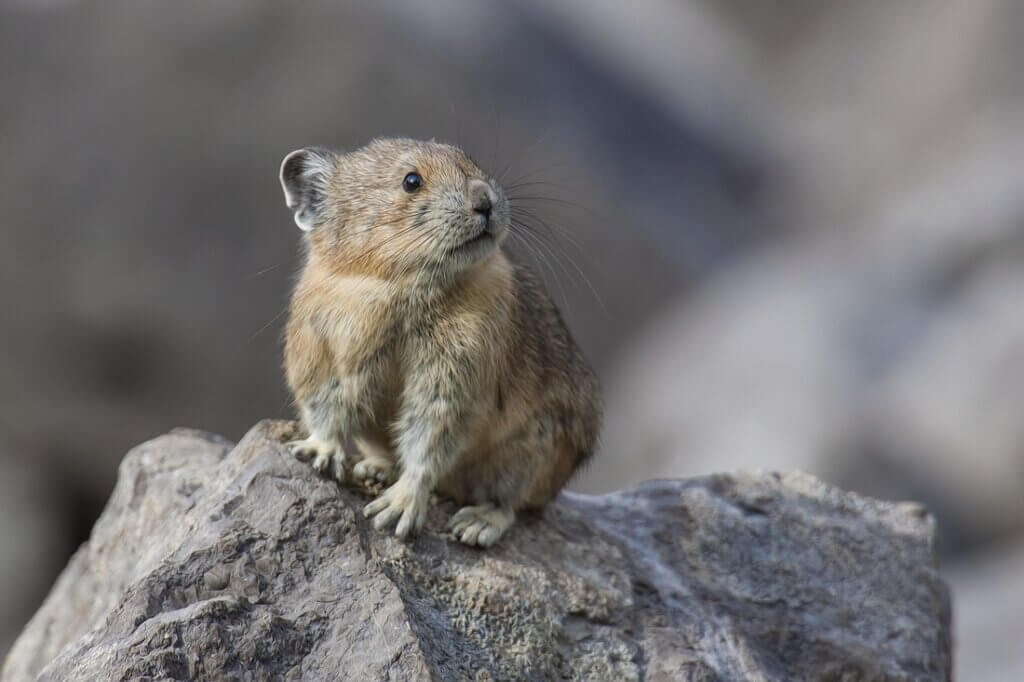When Furry And Tough Isn’t Enough: Pikas And Climate Change
By Jessie Grossman
Broadcast 10.2013, 8.2015, 7.2018, 11.16 & 11.19.2022

Pika, Medicine Lake, Jasper National Park, Alberta. Photo by Alan D. Wilson, naturespicsonline.com, CC-by-SA 3.0.
Listen:
If you are like me, you will probably hear hundreds of pikas before you ever see one. For years, I heard their shrill calls while hiking high ridges and peaks, but no matter how still I stood or how hard I gazed at those rocky mountain slopes, I never saw a real, live pika. Elusive and unique to the western United States, American pikas drove me crazy, taunting me atop a cold, icy mountain summit, nestled deep in a barren talus field under a pile of rocks. They are the last creatures you would expect to find in these places, but their habitat is one where few other mammals ever go—the cold damp climates of high mountain ecosystems.
In Montana I had an easier time finding a gray wolf to watch than sighting a pika. When I finally did see one, I let out an almost identical squeal to the pika’s famed “eek!” The creatures are so—there’s no other word for it—cute. I watched the little animal scurry up a rock pile, then puff up its thick brown and yellow fur in defense of its territory. Mouth opened wide, the pika tried to scare me away with an incessant series of those high-pitched calls.
A pika could stand in your palm if it would stand still for that long. They are constantly scurrying about with their large round ears tucked back against their heads. And if those ears don’t get you, the pika’s long whiskers and mousy nose surely will. Their small heads and round bodies give away their close relationship to rabbits.
Despite their cuddly look, pikas are resilient. In Montana, wolverines get most of the glamour as a no-nonsense creature of extremes, but fluffy pikas are in the running with their affinity for the harsh alpine climes of Montana’s Rocky Mountains. They don’t hibernate, so they spend their days either cutting plants with their teeth for munching on the spot, a process called grazing, or stockpiling food for the winter, which is called haying. They forage and eat while simultaneously looking out for predators on the ground, such as weasels, or airborne predators such as eagles.
A pika that survives the stress of grazing and haying can store up to a bushel, about 35 liters in volume, of plant matter in its home under a rock. For storage, pikas select plants with high nutritional value—lots of fat, protein, and calories—as well as plants that are easily stored over winter. They eat these plants from their hay piles and sometimes use them to feed a litter of baby pikas in the spring if there is too much snow on the ground to begin grazing again. They are fierce in defense of their hay piles, and aren’t opposed to stealing from a neighbor’s cache when stock is low. If they exhaust their hay supply, pikas will even resort to chewing lichen from rocks for food.
While pikas are tiny but tough, there are some things they can’t defend themselves against. One of these threats is warm temperatures. Pikas can die in what, to humans, seems like mild weather—as low as 78 degrees F—which is why they rarely venture into lower elevations. Global climate change threatens pikas and the cold mountainous habitat they depend on. As the planet warms, scientists predict alpine ecosystems will shift upward in elevation—the tree line will become higher, and so will the snow line. This general shift upwards leaves less and less space for the creatures who can only survive near the top, until, perhaps, one day, there will be no rock and ice for pikas—and maybe no pikas at all. For now, pikas are considered an “indicator species” for climate change, meaning people are watching them closely for signs of how climate change will affect mountain regions.
But there is a chance pikas will persist by adapting to warmer temperatures. Pikas may change their habits, searching for food when it is cooler in the morning and night instead of during the day. These resilient little creatures are fighting an uphill battle, and every time I venture into the Rocky Mountains and hear a heart-warming pika squeal, I am hopeful.
Every week since 1991, Field Notes has inquired about Montana’s natural history. Field Notes are written by naturalists, students, and listeners about the puzzle-tree bark, eagle talons, woolly aphids, and giant puffballs of Western, Central and Southwestern Montana and aired weekly on Montana Public Radio.
Click here to read and listen to more Field Notes. Field Notes is available as a podcast! Subscribe on iTunes or wherever you listen to podcasts.
Interested in writing a Field Note? Contact Allison De Jong, Field Notes editor, at adejong [at] montananaturalist [dot] org or 406.327.0405.
Want to learn more about our programs as well as fun natural history facts and seasonal phenology? Sign up for our e-newsletter! You can also become a member and get discounts on our programs as well as free reciprocal admission to 300+ science centers in North America!












